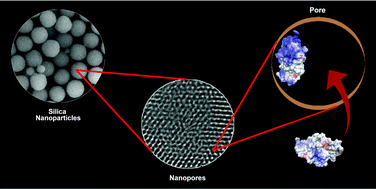Adsorption of lysozyme into a charged confining pore†
Abstract
Several applications arise from the confinement of proteins on surfaces because their stability and biological activity are enhanced. It is also known that the way in which a protein adsorbs on the surface is important for its biological function since its active sites should not be obstructed. In this study, the adsorption properties of hen egg-white lysozyme, HEWL, into a negatively charged silica pore is examined by employing a coarse-grained model and constant-pH Monte Carlo simulations. The role of electrostatic interactions is taken into account via including the Debye–Hückel potentials into the Cα structure-based model. We evaluate the effects of pH, salt concentration, and pore radius on the protein preferential orientation and spatial distribution of its residues regarding the pore surface. By mapping the residues that stay closer to the pore surface, we find that the increase of pH leads to orientational changes of the adsorbed protein when the solution pH gets closer to the HEWL isoelectric point. Under these conditions, the pKa shift of these important residues caused by the adsorption into the charged confining surface results in a HEWL charge distribution that stabilizes the adsorption in the observed protein orientation. We compare our observations to the results of the pKa shift for HEWL available in the literature and to some experimental data.



 Please wait while we load your content...
Please wait while we load your content...